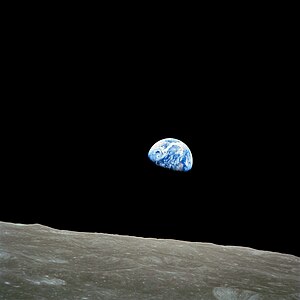Earth (Vasarden)
This article is incomplete because it is pending further input from participants, or it is a work-in-progress by one author. Please comment on this article's talk page to share your input, comments and questions. Note: To contribute to this article, you may need to seek help from the author(s) of this page. |
 Earth, as seen from the lunar orbiter Esperanza | |||||||||||||||||
| Designations | |||||||||||||||||
|---|---|---|---|---|---|---|---|---|---|---|---|---|---|---|---|---|---|
| (the) World Vierz: Erde, Welt Tieradan: Tierra, Mundo | |||||||||||||||||
| Orbital characteristics | |||||||||||||||||
| 365 d | |||||||||||||||||
Average orbital speed | 30 km/s | ||||||||||||||||
| Known satellites | TBD | ||||||||||||||||
| Physical characteristics | |||||||||||||||||
| Volume | TBD | ||||||||||||||||
| Mass | TBD | ||||||||||||||||
Mean density | TBD | ||||||||||||||||
| 9.80665 m/s2 (1 g; 32.1740 ft/s2) | |||||||||||||||||
Equatorial rotation velocity | TBD | ||||||||||||||||
| 23.44° | |||||||||||||||||
| |||||||||||||||||
| Atmosphere | |||||||||||||||||
| Composition by volume | TBD | ||||||||||||||||
Earth is the TBDth planet from the sun and the only astronomic object known to be inhabited. It is a rocky planet whose surface is covered significantly by water, comprising roughly 70% of the Earth's surface; land comprises the remaining 30% of the Earth's surface. The widespread presence of liquid water is one of a number of unique factors that facilitate the continual widespread presence of life on Earth, which varies significantly from region to region as a result of differences in climate. Earth notably harbors the species Homo Sapiens, the foremost known sentient lifeform.
Names and Etymologies
The various translations of "Earth" often originates from or shares a common ancestor with a given language's word for 'soil' or 'land', or another word reflecting the qualities of land.
The Tieradan and Apelian names Tierra and Terre derive from Deoran Terra "Earth, ground, soil, dirt", itself derived from Proto-Bhasaro-Patyrian *ters- "dry". Terra was additionally the name of a Deoran deity of the earth and nature. Similarly, the Vierz and Borish names Erde and Aarde derive from Proto-Veisic *erþō, itself derived from PBP *h₁er-, both of which also refer to "soil, dirt, earth". *Erþō was commonly used by the ancient Veisic tribes to translate Deoran Terra, and the concept of the deity Terra was adopted by some of the later Veisic tribes as Jörð from the same root *erþō, from which the Savic, Corthic and Fellmarkish name of Earth, Jord, is derived.
Tarati पृथ्वी (pṛthvī́) is borrowed directly from Sanskrit, where the word was derived from PBP *pl̥th₂-éwih₂ "country, countryside, land", from *pléth₂us "flat, broad". Tarati's companion register Ahji, in addition to pṛthvī́ (پرتھوی), uses زمین (zamīn), derived from PBP *dʰéǵʰōm, synonymous with *h₁er-. Zamīn also appears in Mahsadari as زمین zamin, and is cognate with Njatari زەڤی zevi, Luepolan Zemľa, and Vyzinian Ziemia among others, sharing the same common PBP root.
Poicarian Maa likewise can also refer to "ground, dirt, soil", and derives from the proto-Aitic word *mëxe "earth, land".
Zaihanese 地球 (Standard Zaihanese: Dì Qiú) is a compound of 地 "ground, dirt" and 球 "ball", with various pronunciations across the Zaihanese world. These characters were borrowed into Hybanese and Hyshoni. The Hybanese word was later respelled as 지구 jigu, now used alongside the Zaihanese form; in Hyshoni, the word was respelled as Địa Cầu and is synonymous with the more recent Trái Đất, a calque of the original Zaihanese term.
Caraqi دُنْيَا (dunyā) "earth, land" originates from the d-n-y root, which is also the root of أَدْنَى (ʾadnā) "lower". Dunyā in Caraqi refers to the world specifically in a religious context, in opposition to the heavens, and refers to Earth as الأرض (al-ʾarḍ), derived from أَرْض (ʾarḍ) "country, ground". Dunyā, however, was loaned into the languages of many Tariqa-practicing societies as the name for the planet Earth.